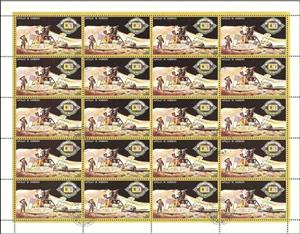Full Pane: astronaut and the U.S.A. flag (Umm al-Qiwain 1972)
astronaut and the U.S.A. flag (Umm al-Qiwain 1972)
17 June (Umm al-Qiwain ) within release Apollo 15 goes into circulation Full Pane astronaut and the U.S.A. flag face value 20*50 United Arab Emirates dirham
| Full Pane astronaut and the U.S.A. flag in catalogues | |
|---|---|
| Colnect codes: | Col: UM 1972.06.17-06c |
Full Pane is square format.
Full pane not mentioned by MichelAlso in the issue Apollo 15:
- Stamp - Astronauts face value 5;
- Full Pane - Astronaut And Space Screwdriver face value 20*25;
- Stamp - Astronaut And Space Screwdriver face value 25;
- Souvenir Sheet - Astronaut And Space Screwdriver face value 25;
- Full Pane - astronaut and the U.S.A. flag face value 20*50;
- Stamp - astronaut and the U.S.A. flag face value 50;
- Souvenir Sheet - astronaut and the U.S.A. flag face value 50;
- Full Pane - Astronaut On The Moon face value 20*10;
- Stamp - Astronaut On The Moon face value 10;
- Souvenir Sheet - Astronaut On The Moon face value 10;
- Full Pane - communicate with Earth face value 20*20;
- Stamp - communicate with Earth face value 20;
- Souvenir Sheet - communicate with Earth face value 20;
- Full Pane - Driving The Rover On The Moon face value 20*75;
- Stamp - Driving The Rover On The Moon face value 75;
- Souvenir Sheet - Driving The Rover On The Moon face value 75;
- Full Pane - First Exit On The Moon With The Rover face value 20*15;
- Stamp - First Exit On The Moon With The Rover face value 15;
- Souvenir Sheet - First Exit On The Moon With The Rover face value 15;
- Full Pane - Transmition Rover face value 20*5;
- Stamp - Transmition Rover face value 5;
- Souvenir Sheet - Transmition Rover face value 5;
- Full Pane - Apollo 15 Flight Space face value 20*5;
- Stamp - Apollo 15 Flight Space face value 5;
- Souvenir Sheet - Apollo 15 Flight Space face value 5;
- Stamp - Astronaut face value 5;
- Full Pane - Astronaut Taking Samples face value 20*1;
- Stamp - Astronaut Taking Samples face value 1;
- Souvenir Sheet - Astronaut Taking Samples face value 1;
- Full Pane - Repairing The Ship face value 20*3;
- Stamp - Repairing The Ship face value 3;
- Souvenir Sheet - Repairing The Ship face value 3;
Full Pane astronaut and the U.S.A. flag it reflects the thematic directions:
An astronaut (from the Ancient Greek ἄστρον (astron), meaning 'star', and ναύτης (nautes), meaning 'sailor') is a person trained, equipped, and deployed by a human spaceflight program to serve as a commander or crew member aboard a spacecraft. Although generally reserved for professional space travelers, the term is sometimes applied to anyone who travels into space, including scientists, politicians, journalists, and tourists
A flag is a piece of fabric (most often rectangular or quadrilateral) with a distinctive design that is used as a symbol, as a signaling device, or as decoration. The term flag is also used to refer to the graphic design employed, and flags have since evolved into a general tool for rudimentary signalling and identification, especially in environments where communication is similarly challenging (such as the maritime environment where semaphore is used). National flags are patriotic symbols with varied wide-ranging interpretations, often including strong military associations due to their original and ongoing military uses. Flags are also used in messaging, advertising, or for other decorative purposes. The study of flags is known as vexillology, from the Latin word vexillum, meaning flag or banner.
The Moon is Earth's only natural satellite. It orbits at an average distance of 384,400 km (238,900 mi), about 30 times the diameter of Earth. Tidal forces between Earth and the Moon have over time synchronized the Moon's orbital period (lunar month) with its rotation period (lunar day) at 29.5 Earth days, causing the same side of the Moon to always face Earth. The Moon's gravitational pull – and to a lesser extent, the Sun's – are the main drivers of Earth's tides.
Outer space (or simply space) is the expanse that exists beyond Earth's atmosphere and between celestial bodies. It contains ultra-low levels of particle densities, constituting a near-perfect vacuum of predominantly hydrogen and helium plasma, permeated by electromagnetic radiation, cosmic rays, neutrinos, magnetic fields and dust. The baseline temperature of outer space, as set by the background radiation from the Big Bang, is 2.7 kelvins (−270 °C; −455 °F)





